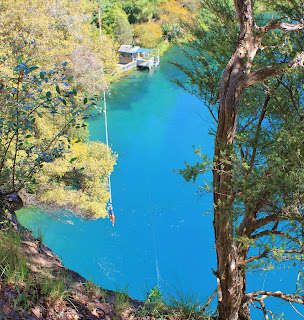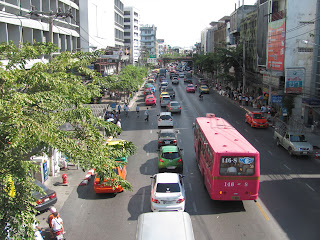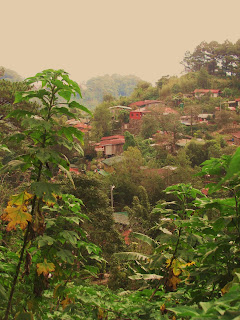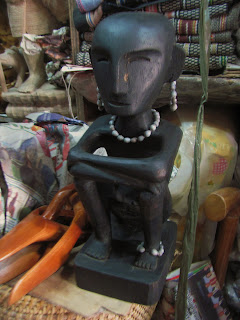My heart is racing like I've just completed a marathon. A single bead of cold sweat trickles down my left temple, pausing for a moment at eye level before plummeting down my cheek. It leaves behind a path of icy fear and I ask myself again why it is I'm doing this. Nobody dared me to, I foolishly volunteered - after which there was no turning back (my kid sister made sure of that).
I take comfort in the fact that the man next to me is just as scared as I am, perhaps even more so. I watch his legs tremble and his fingers twitch, before I introduce myself and shake his hand. His name is Kim and he's from South Korea. As I think to myself that he might be the last person I ever see, I slap that thought from my head as he nods to himself nervously.
A finger appears amid the darkness of a cloudless day and motions for my new friend to step forward. It's his turn to jump - guess who's next? I find myself wondering whether his baby steps towards the instructor are due to stress or fear (completely understandable), or maybe it's because his legs are strapped together in a safety harness.
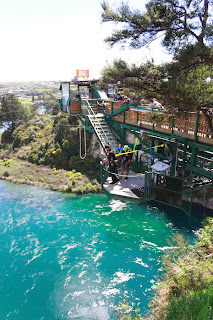 I soon find out as a second instructor appears out of thin air and fits me with all manner of straps and cords. Instead of easing my doubts, it accelerates them to fever pitch. 'There's no backing out now,' I think to myself as I watch Kim preparing himself to walk the plank. A prison yard pace is tough work in such gear, akin to taking part in a Mexican wave while wearing a straitjacket.
I soon find out as a second instructor appears out of thin air and fits me with all manner of straps and cords. Instead of easing my doubts, it accelerates them to fever pitch. 'There's no backing out now,' I think to myself as I watch Kim preparing himself to walk the plank. A prison yard pace is tough work in such gear, akin to taking part in a Mexican wave while wearing a straitjacket."1, 2 ,3... Go," says the instructor with a smirk and rolls his eyes. He's seen it all before a million times.
Cold feet happens to the best of us, but it rarely takes place in the ticket booth - it's always on the jumping ledge. I see Kim squinting in the sunlight, staring down at his shoes and refusing to blink. He looks lost as he glances back behind me, perhaps at his girlfriend in the crowd. He turns to the instructors and shakes his head sadly, his disappointment is obvious.
"1, 2, 3, Go!" says the instructor again, this time with a little more oomph. He checks his watch again and stifles a yawn. Shaking his head, he shares a chuckle with his friend and pushes Kim off the edge. He drops out of sight at once and although his scream is strained and hoarse, it's loud enough to echo down the entire valley.
 "NEXT," bellows the instructor. He grins maliciously in my direction.
"NEXT," bellows the instructor. He grins maliciously in my direction.Terror roots me to the spot, as all my instincts combine forces and beg me not to leap off this perfectly stable ledge. Since approaching the venue, I've made a conscious effort not to look down. It's at this stage however, that guidelines get a little blurry and I take in all that is around me.
Inch by inch, I make my way across the platform and peer down into the turquoise waters of the Waikato River below. My head jerks in another direction, anywhere but down, and I see Lake Taupo in the foreground - New Zealand's biggest lake. Beautiful and majestic indeed, it's not enough to distract me from the horrors at hand.
Hooked up to a weighted rope below the platform, each movement or timid step I take feels like I'm being pulled into an abyss. I wonder for a moment if it's my own imagination, or my brain working against me to try and trick me into turning around.
After seeing what happened to the person who 'jumped' before me, it dawns on me - I don't want to be pushed. I signed up for this precise reason, to be scared out of my mind. I think everyone did. If bungy jumping was a walk in the park, everyone would do it. They wouldn't wait till they were 25, they'd do it in primary school.
Not wanting to speculate or philosophize any further, for fear of being tipped, I open my eyes and exhale the brisk mountain air. I bend at the knees, planning to nose-dive as I've been instructed but before I know it, I'm scrambling about in what could only be described as a mid-air doggy paddle.
Without knowing I'm doing it, my body instinctively braces for an impact that just doesn't come. Instead of speeding up as I had predicted, time slows to a devastating halt and the silence is deafening. It's just me and the rope now, which looks frighteningly like a million rubber bands stuck together.
The water below me is crystal clear and looming closer with each passing second - or is that millisecond? I have no idea how long I've been airborne, but I'm no longer terrified. I come to realise that although I'm out of breath, the mounting pressure makes it impossible to refill my lungs. Instead of worrying about a lack of oxygen, I start to savour the sights around me in a dizzy haze. Rolling hills to my right, green pastures to the left and a flawless blue sky is reflected perfectly on the water's shimmering surface.
Just as I begin to enjoy my free-fall descent, I'm jerked back upwards and the sudden rush of blood to my head forces me to close my eyes. As the elastic pulls me skyward, I feel weightless but at least I can take a breath. It's not like I imagine flying to be, yet more like drifting aimlessly in space. I have no control as to which direction I float and can only flail my limbs helplessly.
 After sufficiently bobbing up and down like a yo-yo, it's time to return to life on land. To do this is no easy process, as I must grab hold of a steel rod and lower myself into a rubber boat. Once the self-dubbed 'search and rescue' team remove the cord and harness, the banter begins.
After sufficiently bobbing up and down like a yo-yo, it's time to return to life on land. To do this is no easy process, as I must grab hold of a steel rod and lower myself into a rubber boat. Once the self-dubbed 'search and rescue' team remove the cord and harness, the banter begins."What was it you screamed out on the way down?" asks the boat driver, with a curious expression on his face.
"I told you so," I reply. "My sister told me I wouldn't have the guts to go through with it."
"You're nuts bro," he laughs. "No way would I ever do that!"
At first I think he's joking, as staff members must be privy to discounted jumps year-round or freebies on their birthday. I notice though, that he's not laughing so perhaps his fear of heights is genuine. I think to myself that it's probably no coincidence he's working at the bottom of the jump, rather than the top, as he would hardly be a motivating factor to prospective jumpers in the ticket booth.
SIDEBAR - Although not yet as well known as its South Island counterpart Queenstown, Taupo is also becoming a mecca for extreme sports. For those irked by the idea of dangling 47 meters above the ground by a giant rubber band, there is also world-class skydiving on offer and high-speed jet boating. The latter of which is a distinctly New Zealand activity and sure to get your adrenaline pumping.
Those looking for more sedate activities will be pleased to know they can also enjoy Taupo without risking life and limb. Lake Taupo prides itself on being the 'rainbow trout capital of the world,' so anglers take note! Fishing expeditions are offered at local tackle shops, while rods and reels can also be rented out for the day. Scenic flights are offered in the form of small planes and helicopters, while those wishing to remain on dry land can take advantage of the region's renowned wineries or take guided walks through the mountains.
For more information on bungy jumping and other extreme sports in Taupo, please visit - http://www.taupobungy.co.nz/

